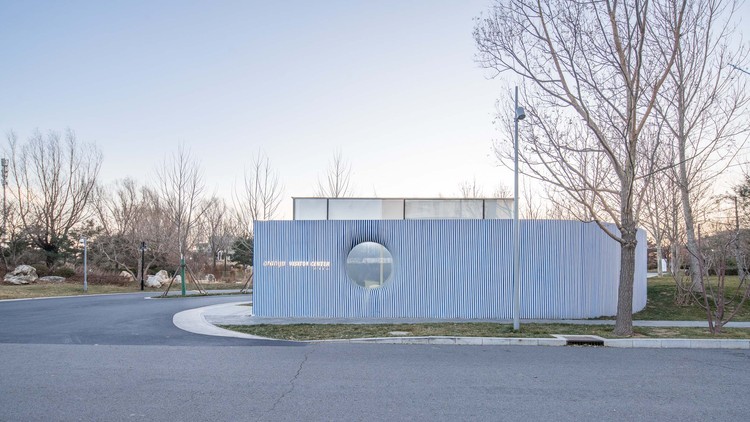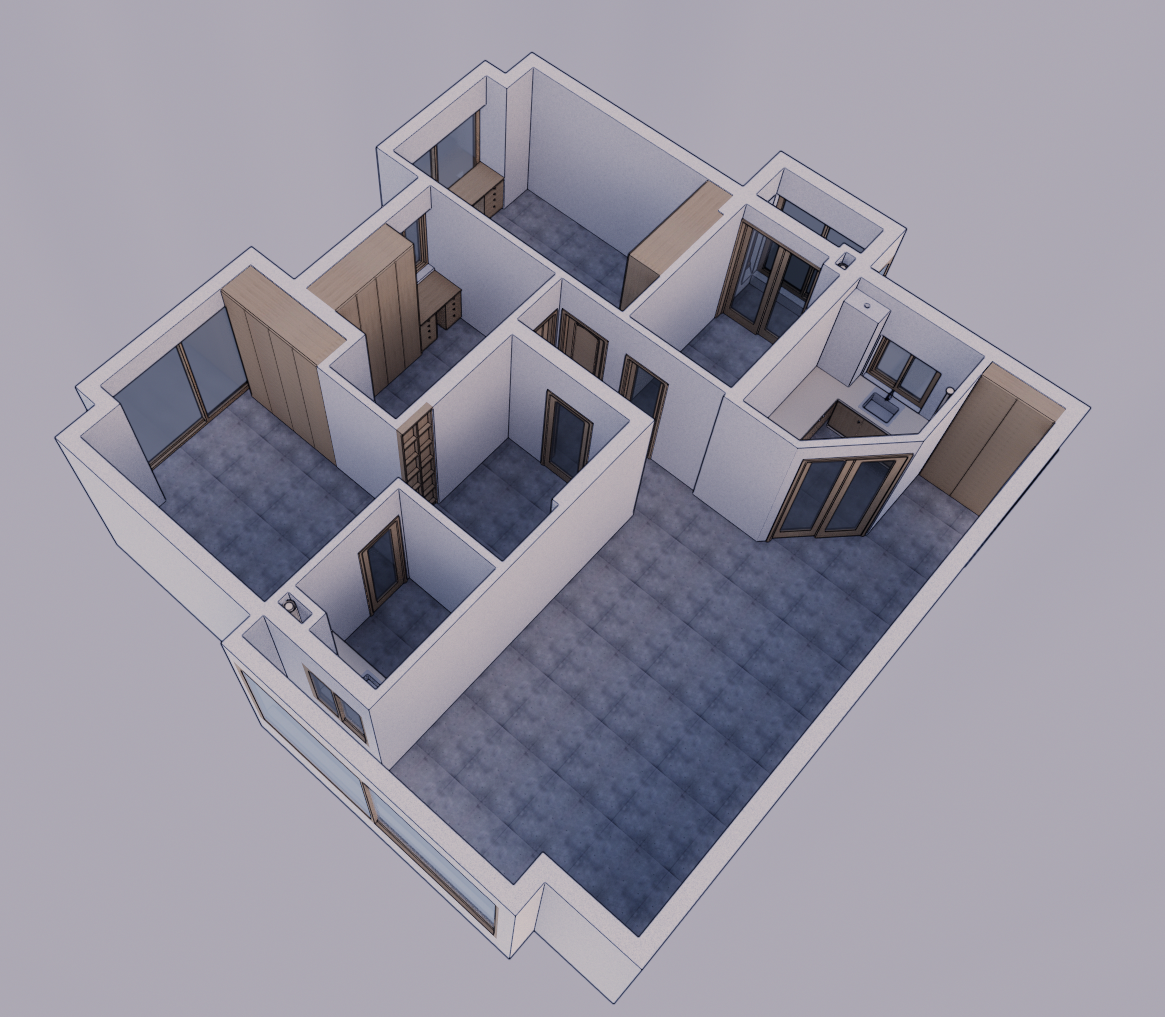Zhonghe Sports Center Q
2015-03-09 21:00
© Highlite Images
海来石图像


架构师提供的文本描述。设计分析
Text description provided by the architects. Design Analysis
传统上,台湾大部分地区的体育中心都是在拥挤的城市织物内建造的,就像办公大楼一样。因此,这些建筑物往往无法充分发挥其潜力,也无法在社会参与和空间安排方面向公众开放更多的机会。这些建筑物内的程序通常是由地板隔开,这些楼板可以使活动脱离活动,并阻断彼此之间的视觉联系,游客们往往别无选择,只能乘坐电梯到达他们想要的目的地。缺乏空间和视觉品质往往是这种建筑的后果或症状,特别是在台湾的大城市。Q-Lab理解潜在的挑战,并决定将项目与城市化以及社会议程结合起来。
Traditionally, most of the district-based sports centers in Taiwan were built like office buildings nested within crowded urban fabrics. As the result, these buildings often do not reach their full potential nor open up more opportunities to the general public in terms of social engagements and spatial arrangements. Programs inside these buildings are typically separated by floor slabs which disengage activities and block visual connections from each other, visitors were often left without choices but to take elevators to arrive to their desired destinations. The lack of spatial and visual qualities was often the aftermath or syndromes of this building type, particularly in the metropolitan cities of Taiwan. Q-Lab understands the underlying challenges and decides to engage the project with urbanistic approach as well as social agendas in mind.
© Highlite Images
海来石图像


Design Condition
该地点位于一个大型游憩公园内,内建筑物的足迹较小。地块的北面是一条主干道,东面是一个现有的停车场,西边是一个游泳设施,南边是一个室外篮球场。现有的公用设施,如煤气管道和现场的水污水,将按照设计准则予以保留。此外,预算总额仅为每平方米13K美元,而国际标准为每平方米25000美元。
The given site is located inside a large recreational park with a small footprint for buildings to be erected within. The plot is bounded by a main road to the north, an existing parking lot to the east, a swimming facility to the west and an outdoor basketball court to the south. Existing utilities such as gas pipes and water sewage on site were to be kept according to the design guidelines. In addition, the overall budget is given at only US$13k per square meter in comparison to the international standard of US$25k per square meter.
© Highlite Images
海来石图像


Design Concept
这个设计是从一个城市分析开始的,它有助于确定主楼的位置和建筑的高度。然后,建筑物遵循总体规划原则,并根据与其相关的指导方针发展。体育中心的设计理念产生于将所有所需的节目以最紧凑的形式堆叠在一起的想法,它结合了有趣的建筑部分,将室内空间与室外环境结合起来,同时,还涉及到具有视觉连通性的空间布局。一个重大的决定是把曲棍球场建在远离主建筑的地方,把它深埋在地下室里,只露出上面覆盖着草的三角状屋顶。通过这样做,我们能够降低建筑高度,减少在建筑质量和规模方面的城市拥堵。此外,草和土覆盖曲棍球场的屋顶,可以防止夏天的热量直接进入室内空间。结果,进一步减少了冷却负荷,为中河区创造了更可持续的环境。
The design begins from an urbanistic analysis that helps determine where the main building was to be located and at what height it was to be built. The building then follows the overall master plan principal and develops from the guidelines associated with it. The design concept of the sports center was then generated from the idea of stacking all the required programs in the most compact form, which incorporates playful building sections that engage indoor space with outdoor surroundings, and at the same time, involves spatial arrangements with visual connectivity. One big decision was to house the field hockey rink away from the main building and bury it deep into the basement, revealing only its triangulated roof with grass covered on top. By doing so, we were able to reduce the building height and create less urban congestion in terms of building mass and scale. Moreover, with grass and soil covering the roof of the hockey rink, one was able to prevent summer heat penetrating directly into the interior space. As the result, cooling load was further reduced, and a more sustainable environment was possible for the district of Zhonghe.
© Highlite Images
海来石图像


设计执行
Design Execution
在建筑预算较低的情况下,施工方法、材料选择以及建筑几何对实现设计意图都同样重要。Q-Lab花费了大量的时间来寻找最优的建筑几何形状,这样所有的柱间距都是相等和对齐的,所有的立面都将被调制和统一,所有的结构件都可以很容易地安装和组装。此外,为进一步节省成本,只有大跨度的空间采用钢结构,而其余的建筑则采用钢筋混凝土在较低的楼层建造。一楼的中庭设计为双高空间,两侧都有夹层,贯穿整栋大楼,使桥墩感觉开阔宽敞,看不到障碍物。这个中庭空间被设计成一个城市起居室,欢迎拥有明亮空间的游客,并为人们提供留宿的城市家具。夹层有一个健身室,一个旋转自行车室和三个瑜伽室。三楼有六个羽毛球场和两个壁球场。四楼有两个篮球场和一个攀岩室。这四层楼被捆绑在一起,形成了一座“主建筑”,它的外部是多面的,与丘陵的周围相呼应。另一方面,曲棍球场被拉离了主楼,只向公众展示了它绿色的屋顶,窗户是三角状的,人们可以在下面窥视。这个三角形的屋顶长近60米,宽30米,没有一根柱子。此外,在举办比赛时还提供了200多个B1级座位。
With low building budget, construction methods, material selections as well as building geometry were all as important to help realize the design intention. Q-Lab spent a tremendous amount of time in finding the optimal building geometry so that all the column spacing would be equal and aligned, all the facades would be modulated and unitized, and all the structure pieces would be easily erected and assembled. Moreover, to further save cost, only long-span spaces were realized with steel structure, while the rest of the building was constructed with reinforced concrete on the lower floors. The atrium on the first floor was designed to be a double height space with mezzanine levels on both sides all the way through the entire length of the building so that the plinth feels open and spacious with no obstruction in sight. This atrium space is designed to function as an urban living room, which welcomes visitors with well-lit space and features urban furniture for people to linger and stay. The Mezzanine level hosts a fitness room, a spinning-bike room and three yoga rooms. The third floor hosts six badminton courts and two squash courts. The fourth floor houses 2 basketball courts and a rock-climbing room. These four floors were bundled together to form the “main building” with a faceted exterior that speaks to the hilly surrounding. The field-hockey rink on the other hand was pulled away from the main building and reveals only its green roof to the general public with triangulated windows for people to peek below. This triangulated roof spans almost sixty meters in length and 30 meters in width without one single column. In addition, more than two hundred seats at B1 level were provided when games were hosted.
© Highlite Images
海来石图像


台湾的体育中心是一个见面、看的地方。它是一种建筑类型学,它处理严格的体育要求,同时又参与社会协议和议程。Q-Lab以对其本地环境的了解来对待设计,并使其具有结构表达和架构完整性。我们努力使公共建筑在空间和形式上都具有动态质量,具有社会性和可访问性。中和体育中心打破了传统建筑类型学的规范。这是一个见面、看到和被看到的地方。
A sports center in Taiwan is a place to meet, to see and to be seen. It is a building typology that deals with strict sports requirements and at the same time, engages pubic with social protocols and agendas. Q-Lab approaches the design with awareness of its local environment and renders it with structural expression and architectural integrity. We strive to make public buildings sociable and accessible with dynamic quality in both space and form. Zhonghe Sports Center breaks the norm from conventional building typology. It is a place to meet, to see and to be seen.
© Highlite Images
海来石图像




























































































Architects Q-Lab
Location Zhonghe District, New Taipei City, Taiwan 235
Category Gymnasium
Principal Sense Tseng, Borden Tseng
Design Director Borden Tseng
Project Manager Tunghan Wu
Project Designers Liyu Chen, Jimmy Chang, Junyang Wang
Area 12090.0 sqm
Project Year 2014
Photographs Highlite Images
























